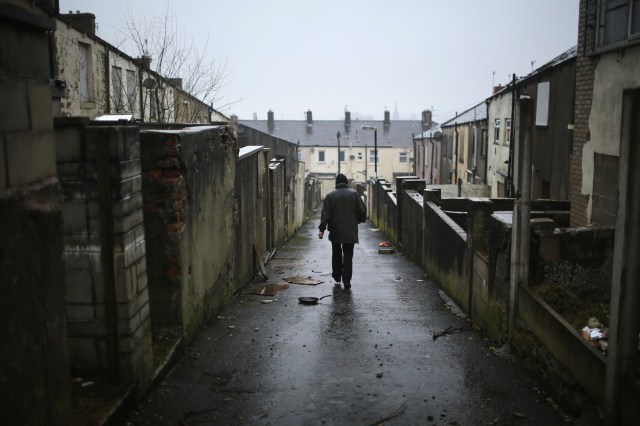Credit: Christopher Furlong/Getty Images

This week on UnHerd, James Bloodworth writes powerfully about the rural communities left behind by cuts to public transport. Equally recommended is a report by Chris Osuh and Steve Robson for the Manchester Evening News, which is about a very different kind of left-behind community.
Clayton in east Manchester is a world apart from the villages and small towns of Bloodworth’s native Somerset. The area is well-connected to the city centre – and a stone’s throw from the Etihad Stadium, home of Manchester City Football Club. And yet there are whole streets in the suburb that are all but abandoned.
Osuh and Robson begin their report with a visit to one of the few remaining residents of Heather Street:
“Pete’s home is one of only three or four others on the street that are occupied. The rest are boarded up in brutal fashion.
“Windows and doors are covered with imposing metal grates or wooden plyboard covered in graffiti, with the occasional heavy-duty padlock added for good measure.
“And it’s not just on Heather Street.
“Both the next one along – Ben Street – and behind – Midlothian Street – are the same.
“Blighted by dozens and dozens of vacant properties, this is a neighbourhood that was at death’s door.”
These streets are just three miles drive from the centre of England’s second city (sorry, Birmingham). Can you imagine this happening three miles from the centre of London?
The root cause of the area’s decline is the old story of de-industrialisation. However, Manchester has been on the up for at least twenty years now:
“Manchester’s population has grown – leaping 28 per cent between 2001 and 2011. House prices are up 32.5 per cent in the last five years, according to Land Registry data – and younger workers want to live close to town, and are increasingly priced out of the suburbs and the city centre.”
So why haven’t places like Heather Street been reclaimed?
The basic problem is that neighbourhood decline and regeneration is an asymmetric process. The decline happens bit-by-bit, residents and landlords walking away from worthless properties one-by-one. Regeneration, however, requires a collective effort.
While a private individual may be able to renovate an abandoned property in an otherwise thriving street, they’d be ill-advised to do so in a street full of other abandoned properties. In the latter case, regeneration is an all-or-nothing proposition requiring major investment – most likely, public investment.
For Heather Street and its neighbours, that investment is now underway, but why did it take decades for the various branches of the state to get their act together?
What struck me reading the authors’ account of what happened (or, rather, what didn’t happen) was the lack of urgency on the part of those who should have got things moving. Clearly, there’s something lacking in the policy framework to prod the powers-that-be into action.
A land value tax (LVT) is exactly what it purports to be – a tax on the market value of a piece of land, not on what’s built on it. If implemented it would make sitting on a site – whether out of speculative expectation or mere indolence – prohibitively expensive. This is presented as a major advantage of the system: an LVT forces private landlords to redevelop poorly used land or sell it on to someone who will.
But what if dereliction is so widespread that individual landlords are powerless to make a difference? What if land values have fallen so far that not much LVT is payable anyway? How can LVT be made to drive regeneration in these circumstances?
In theory, the loss of LVT revenues would give the state an incentive to act to restore land values. In practice, however, bureaucratic inertia could win the day.
But what if land value taxes included a threshold land value below which they went negative – i.e. the state would have to pay the land owner? This would turn the opportunity cost of inaction into an actual cost – a much sharper incentive to get going on regeneration. There’d be an important condition attached to the negative LVT system, which is that the state would have the right to buy the property at its negatively taxable value – thus enabling it to assemble the land packages required to make a regeneration scheme work.
Finally, on the assumption that the system were administered by local government, I’d give each local authority the right to transfer its operation in a particular neighbourhood to central government – including the liability for negative LVT payments. This would give central government every reason to make sure that local government had the powers and capital required to regenerate left-behind communities – or to do the job itself.










Join the discussion
Join like minded readers that support our journalism by becoming a paid subscriber
To join the discussion in the comments, become a paid subscriber.
Join like minded readers that support our journalism, read unlimited articles and enjoy other subscriber-only benefits.
Subscribe